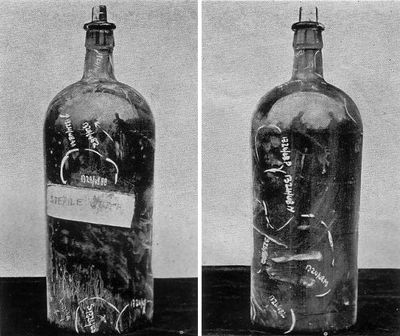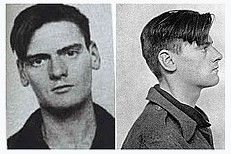~~~~~~~~~~~~~~~~~~~~~~~~~~~~~~~~~~~~~~
June Anne Devaney was only three years old in the spring of 1948 and had a mild case of pneumonia. Her parents, Albert and Emily checked her into Queen's Park Hospital in Blackburn on May 5. She was placed in Ward CH3 under the care of nurse Gwendolyn Humphreys. By May 14, little June was much improved and due to go home the next day. However, at 1:30 on May 15, nurse Humphreys went to investigate a draft from an open door. She found June's cot empty, surrounded by footprints from adult stocking feet plainly visible on the highly polished floor. The side of the crib-like cot was still up, meaning someone had taken the girl from her bed.
Ward CH3, Queen's Park Hospital. June Devaney slept is the cot second from left. Note white footprints on the waxed floor.
Nurse Humphreys frantically searched the ward looking for June before raising the alarm. She and other hospital staff continued to search for the child for about 30 minutes without success. Then they called the police.
Police didn't have to search for long. At 3:17, they found little June's body lying face down next to an eight-foot wall. It was clear from her injuries that the police had a murder to investigate. Detective Chief Inspector John Capstick caught the 6:20 train from Euston Station in London to Blackburn.
Scotland Yard Investigates the June Devaney Murder
June's autopsy showed that she died from shock following severe blunt force trauma to the head. The pathologist theorized that her killer had held her by her legs and swung her against the wall near where police found her body. She also suffered other injuries both internal and external prior to death.
The Winchester bottle found near June's cot. White marks show where Inspector Colin Campbell found fingerprints.
Ward CH3 revealed two significant clues. First, footprints on the waxed floor indicated the killer had prowled through the ward. Apparently, he had peered into each of the cots before selecting June Devaney as his victim.
Police found a second and potentially more useful clue in the Winchester bottle they discovered near June's cot. Examiners found several fingerprints on the bottle, but they didn't match any in Scotland Yard's files. The bottle was not in its proper place, leading investigators to conclude that the killer had moved it. This meant the fingerprints were likely his.
An Unusual Strategy for the Investigation
Since there was no match for the fingerprints on the bottle, DCI Capstick took an unusual step. He decided to take the prints of every male in Blackburn age 16 and over. The printing was voluntary, and police promised to destroy the prints after the investigation was over. No police force in England had ever attempted an operation of this type before.
Armed with the Electoral Registry, Inspector William Barton and 20 other officers began the task of taking fingerprints. After two months, they had visited over 35,000 homes and collected more than 40,000 prints. Frustratingly, the killer's prints were not among them. Next, they compared the Electoral Registry with people registered for ration books at the local Food Office. They found over 200 men whose prints they hadn't taken.
Police log and check the fingerprints of the more than 40,000 men in Blackburn to find the killer of June Devaney
Police log and check the fingerprints of the more than 40,000 men in Blackburn.
The expanded search led them to 31 Birley Street, the home of one Peter Griffiths. Griffiths, 22, was an ex-serviceman who worked nights at a local flour mill. And his niece had been in Queen's Park Hospital the night June Devaney disappeared. When police compared his fingerprint card to the prints from the Winchester bottle, they matched.
Arrest and Trial
DCI Capstick arrested Griffiths on August 12 as he left his home to go to work. At first, Griffiths denied any involvement in the crime. That changed when Capstick confronted him with the fact that his fingerprints were on the Winchester bottle. Soon police had a complete confession.
Griffiths went on trial before Mr. Justice Oliver on October 15, 1948, six months after the murder. The prosecution relied on forensic evidence, the most significant being the fingerprints. Inspector Colin Campbell testified to the prints and showed enlarged copies of the to the jury. The defense argued that Griffiths was legally insane at the time of the killing.
Griffiths' fingerprint card, proved his guilt in the June Devaney murder
The jury retired to consider its verdict after a two-day trial. They only took 23 minutes to return with a guilty verdict. Mr. Justice Oliver donned the ceremonial black cap and sentenced Griffiths to death.
Epilogue
Griffiths did not appeal his conviction. He was hanged at H.M. Prison Liverpool (formerly Walton Gaol) on the morning of November 19, 1948.
Just weeks before Griffiths' hanging, authorities publicly destroyed the fingerprint cards they collected during the investigation at a local papermill. Several local journalists were present to witness as the cards became pulp.∼A.K.A.: "The Blackburn baby murderer"
Classification: Murderer
Characteristics: Kidnapping from a hospital - Rape
Number of victims: 1 +
Date of murder: May 14, 1948
Date of arrest: August 13, 1948
Date of birth: 1926
Victim profile: June Ann Devaney (female, 4)
Method of murder: Banging her head against a wall
Location: Blackburn, Lancashire, England, United Kingdom
Status: Executed by hanging at Walton Gaol on November 19, 1948
~~~~~~~~~~~~~~~~~~~~~~~~~~~~~~~~~~~~~~
June Anne Devaney was only three years old in the spring of 1948 and had a mild case of pneumonia. Her parents, Albert and Emily checked her into Queen's Park Hospital in Blackburn on May 5. She was placed in Ward CH3 under the care of nurse Gwendolyn Humphreys. By May 14, little June was much improved and due to go home the next day. However, at 1:30 on May 15, nurse Humphreys went to investigate a draft from an open door. She found June's cot empty, surrounded by footprints from adult stocking feet plainly visible on the highly polished floor. The side of the crib-like cot was still up, meaning someone had taken the girl from her bed.
Ward CH3, Queen's Park Hospital. June Devaney slept is the cot second from left. Note white footprints on the waxed floor.
Nurse Humphreys frantically searched the ward looking for June before raising the alarm. She and other hospital staff continued to search for the child for about 30 minutes without success. Then they called the police.
Police didn't have to search for long. At 3:17, they found little June's body lying face down next to an eight-foot wall. It was clear from her injuries that the police had a murder to investigate. Detective Chief Inspector John Capstick caught the 6:20 train from Euston Station in London to Blackburn.
Scotland Yard Investigates the June Devaney Murder
June's autopsy showed that she died from shock following severe blunt force trauma to the head. The pathologist theorized that her killer had held her by her legs and swung her against the wall near where police found her body. She also suffered other injuries both internal and external prior to death.
The Winchester bottle found near June's cot. White marks show where Inspector Colin Campbell found fingerprints.
Ward CH3 revealed two significant clues. First, footprints on the waxed floor indicated the killer had prowled through the ward. Apparently, he had peered into each of the cots before selecting June Devaney as his victim.
Police found a second and potentially more useful clue in the Winchester bottle they discovered near June's cot. Examiners found several fingerprints on the bottle, but they didn't match any in Scotland Yard's files. The bottle was not in its proper place, leading investigators to conclude that the killer had moved it. This meant the fingerprints were likely his.
An Unusual Strategy for the Investigation
Since there was no match for the fingerprints on the bottle, DCI Capstick took an unusual step. He decided to take the prints of every male in Blackburn age 16 and over. The printing was voluntary, and police promised to destroy the prints after the investigation was over. No police force in England had ever attempted an operation of this type before.
Armed with the Electoral Registry, Inspector William Barton and 20 other officers began the task of taking fingerprints. After two months, they had visited over 35,000 homes and collected more than 40,000 prints. Frustratingly, the killer's prints were not among them. Next, they compared the Electoral Registry with people registered for ration books at the local Food Office. They found over 200 men whose prints they hadn't taken.
Police log and check the fingerprints of the more than 40,000 men in Blackburn to find the killer of June Devaney
Police log and check the fingerprints of the more than 40,000 men in Blackburn.
The expanded search led them to 31 Birley Street, the home of one Peter Griffiths. Griffiths, 22, was an ex-serviceman who worked nights at a local flour mill. And his niece had been in Queen's Park Hospital the night June Devaney disappeared. When police compared his fingerprint card to the prints from the Winchester bottle, they matched.
Arrest and Trial
DCI Capstick arrested Griffiths on August 12 as he left his home to go to work. At first, Griffiths denied any involvement in the crime. That changed when Capstick confronted him with the fact that his fingerprints were on the Winchester bottle. Soon police had a complete confession.
Griffiths went on trial before Mr. Justice Oliver on October 15, 1948, six months after the murder. The prosecution relied on forensic evidence, the most significant being the fingerprints. Inspector Colin Campbell testified to the prints and showed enlarged copies of the to the jury. The defense argued that Griffiths was legally insane at the time of the killing.
Griffiths' fingerprint card, proved his guilt in the June Devaney murder
The jury retired to consider its verdict after a two-day trial. They only took 23 minutes to return with a guilty verdict. Mr. Justice Oliver donned the ceremonial black cap and sentenced Griffiths to death.
Epilogue
Griffiths did not appeal his conviction. He was hanged at H.M. Prison Liverpool (formerly Walton Gaol) on the morning of November 19, 1948.
Just weeks before Griffiths' hanging, authorities publicly destroyed the fingerprint cards they collected during the investigation at a local papermill. Several local journalists were present to witness as the cards became pulp.∼A.K.A.: "The Blackburn baby murderer"
Classification: Murderer
Characteristics: Kidnapping from a hospital - Rape
Number of victims: 1 +
Date of murder: May 14, 1948
Date of arrest: August 13, 1948
Date of birth: 1926
Victim profile: June Ann Devaney (female, 4)
Method of murder: Banging her head against a wall
Location: Blackburn, Lancashire, England, United Kingdom
Status: Executed by hanging at Walton Gaol on November 19, 1948
Sponsored by Ancestry
Advertisement
Advertisement








